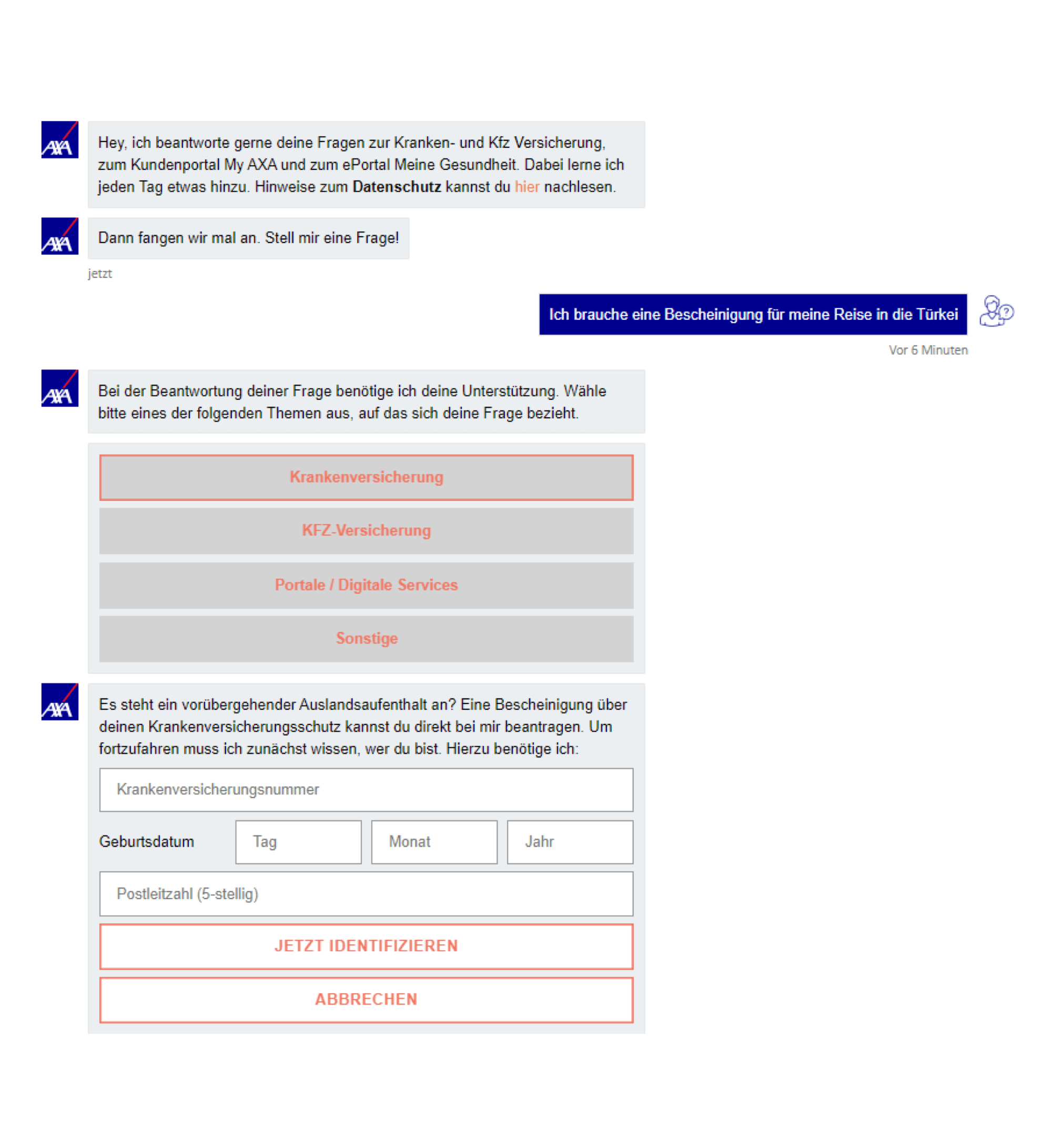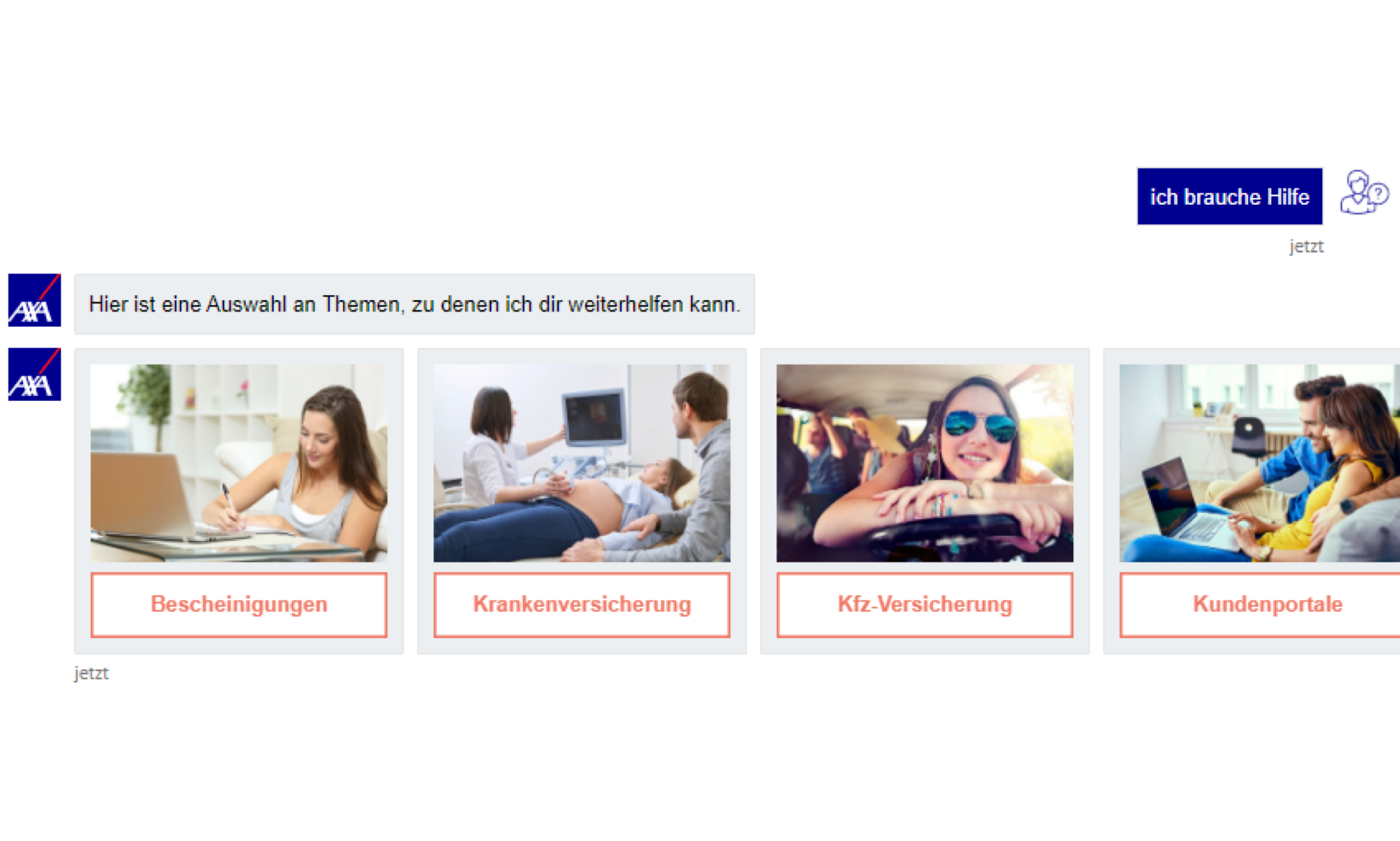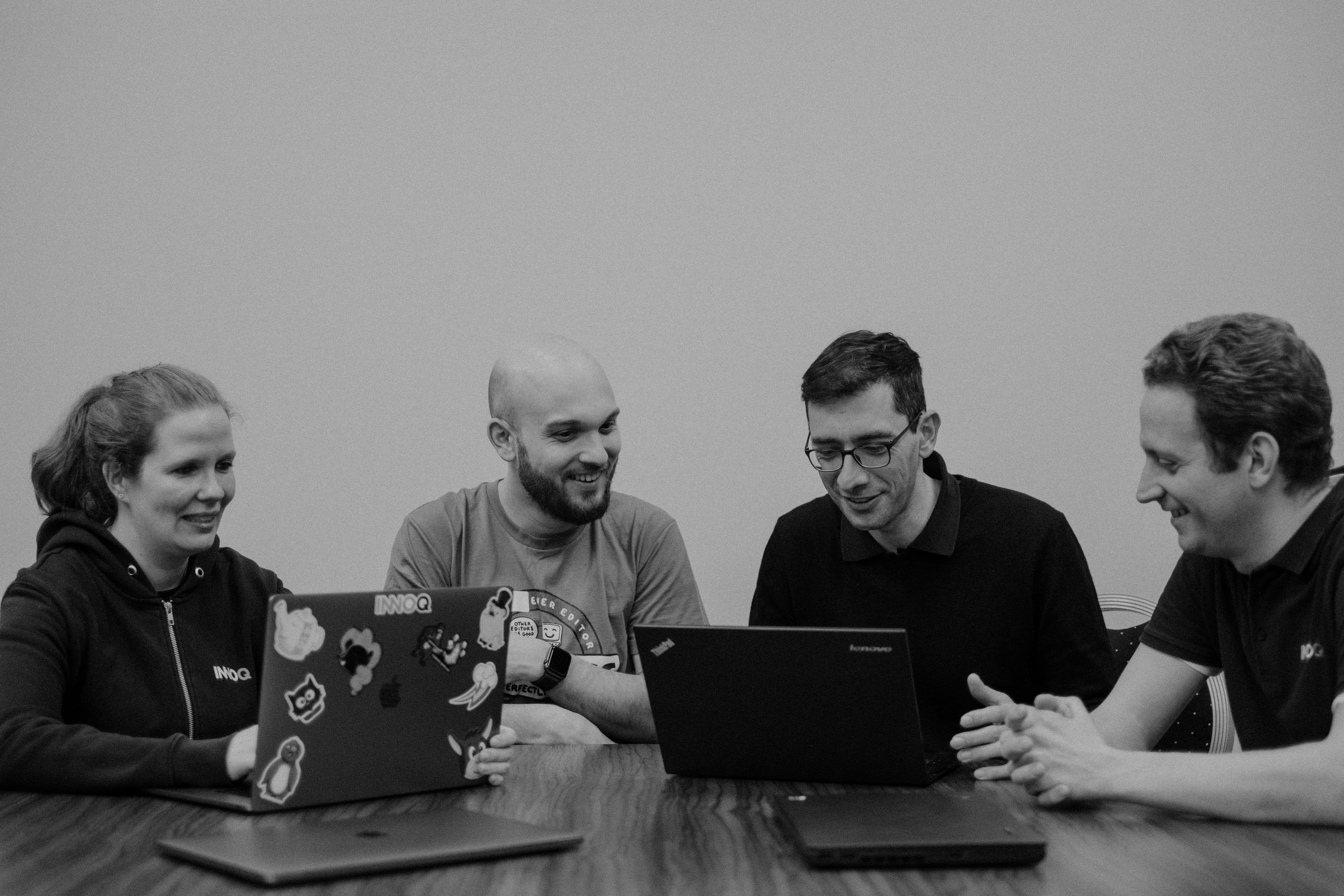
Diese Case Study ist auch auf Deutsch verfügbar
Wait times are a thing of the past
In customer satisfaction, the time it takes to get answers to questions plays an important role. Using a chatbot means that wait times are a thing of the past in phone-based customer service. The AXA-Chatbot answers customers immediately and takes care of their concerns. In addition, service hours are expanded, offering 24/7 support to customers even on Sundays and holidays.
This also provides support to customer service staff for routine inquiries that can be answered by the chatbot without any problem. On the website, the customer communicates with the chatbot via messaging and also gets an answer in the form of a message. Customer service staff no longer have to deal with repeat questions and can thus concentrate on more demanding inquiries. For customers, the conversation seems natural, even though it is clear that they are communicating with a chatbot.
Implementation of the AXA-Chatbot with the Microsoft Bot Framework
In customer support today, it would be hard to find a topic more popular than chatbots and AI. A chatbot is a symbolic representation for the communication between a person and a computer.
The core technology of the AXA-Chatbot was not a completely new development by the Product Team but is based on the Microsoft Bot Framework. The framework created the prerequisites for fast implementation of a bot for the AXA website.
With the help of the BotFramework-WebChat React plug-in, it was possible to integrate the bot on the AXA website. A direct-line connection enables the website to access the bot. Other channels, such as Skype, Teams, and other chat-based applications can use this access via direct line. For security reasons, the AXA-Chatbot and all other parts of the solution run in a self-hosted environment.
In the MyAXA Project, we had already gotten to know and appreciate the competency of INNOQ as a technical partner. This impression was reconfirmed in the development of the AXA-Chatbot. In particular, the success of the project was facilitated by the good collaboration in the Project Team, consisting of AXA and INNOQ staff.
Mario ClassenProject Lead
The chatbot as a learning support colleague
Of particular importance in the development of the chatbot was the logic. The bot must process inquiries by AXA customers and provide them with the appropriate answers. In fact, the chatbot is able not only to answer simple, repetitive questions, but, thanks to progress in machine learning, can also handle more demanding tasks.
For instance, if a customer wants to replace an insurance card, the chatbot handles the entry of the necessary data and initiates the replacement process. The chatbot now offers a number of such self-services.

Aside from handling matters for the end customer, the chatbot can also be used internally: It is conceivable that service staff could also use the chatbot to answer questions faster. For instance, if a customer is interested in whether AXA pays for a medication, the employee previously had to search for the answer in the existing system, which could take some time. Enabling the service person to pose the question to the chatbot makes it possible to get the answer from the bot in real time.
1. Identifying important information in a conversation
The Cognitive Services from Microsoft are a component of Microsoft Azure and combine multiple AI services. Through the Language Understanding Intelligent Service LUIS, the bot is able to process natural language (Natural Language Processing*, NLP). As a result, important keywords from conversations can be filtered, and the intent and associated entities of the user can be identified. An entity is a word or expression within the utterance and describes information in regard to intent.
Even if a customer enters a sentence or series of words with errors in grammar, spelling, or punctuation, it is still possible to determine the context. Missing information can thus be determined through a dialog with AXA customers.
Natural language processing (NLP) is a subfield of linguistics, computer science, information technology, and artificial intelligence that deals with the interactions between computers and human (natural) languages, specifically how to program computers to process and analyze large amounts of natural language data.
Challenges in natural language processing often include speech recognition, natural language understanding, and natural language generation.
2. Providing answers based on technical models and frequently asked questions
On the basis of the entities and intents found and the text entered, Azure Search searches a database for answers. Technical specialists fill the LUIS models and the database as technical models. For this purpose, the specialists use an administrative web interface that was developed in the course of the project. Interestingly, user tests showed that many users use the bot in a manner similar to a Google search, entering only keywords instead of whole sentences. Consequently, the team also implemented a list of keywords, which makes it possible to provide direct answers to frequently asked questions. If the bot is uncertain, it independently questions the user to determine the context more precisely and then provides an answer. The Service Department is contacted only if this fails.

Generally, messages are not restricted to text only, but can also include hyperlinks or images. In this way, answers can be tailored individually to the users.

3. Continuous learning and improvement
As time goes by, the chatbot learns and gets better with each inquiry. Among other things, this is achieved through user tests and analysis of the questions asked of the chatbot. If the chatbot does not provide any sensible answers to the questions asked, the cause is sought and the model revised accordingly.
4. If all else fails: emergency exit
If the chatbot reaches its limits and cannot help the customer further, in addition to a reference to the telephone hotline, there is also an option to use a button to establish a chat connection to a service agent in the corresponding AXA department.

Core technologies:
- Chatbot: a server application based on node.js running in a docker container in the Azure Cloud. The frameworks used are Microsoft Bot Framework and express.
- LUIS: internal local LUIS copy (natural language processing/machine learning) running in a docker container on the same Azure Cloud instance. Direct line: connection between the website and the chatbot, making it possible to access the chatbot via other channels.
- Data proxy: a Spring Boot application runs on a JBoss server in the AXA infrastructure and provides a “REST” interface as a bridge to the AXA back-end systems (e.g. search for medications, application for certifications, insurance cards, etc.)
The epitome of an agile project team
Getting closer to the project goal step by step and ensuring that we do not lose track of the real users required an agile work environment. In order to achieve agility and assemble the necessary knowledge, it is essential to have an interdisciplinary team. At AXA, this problem was solved in an exemplary way. The team is made up of AXA and INNOQ personnel and includes the project manager and product owner, software developers, and two insurance experts in the respective areas of health insurance and car insurance.

How AXA profits from the chatbot:
- The chatbot integrated on the website permits direct communication between customers and the company.
- Customers can contact the AXA-Chatbot and get help without any wait time, 24 hours a day, 7 days a week, and 365 days a year, even at peak loads.
- The system offers automatic and complete processing of interactions, such as requests for information, making it possible to solve problems directly.
- Self-services offer customers fast, uncomplicated satisfaction of their needs, without requiring users to utilize web solutions like MyAXA, which require authentication with PostIdent.
- Capability to support the complete customer journey in a customer dialog, thus improving the customer experience and customer satisfaction.
- The chatbot lightens the load on service employees by answering simple and recurring questions.
- The chatbot also provides internal support by searching a large volume of data to rapidly find the information the service agents need, and providing it to them quickly.
- Thanks to the flexibility of the framework, the function of the chatbot can be expanded easily.
